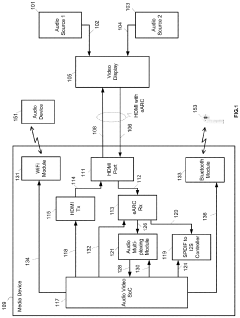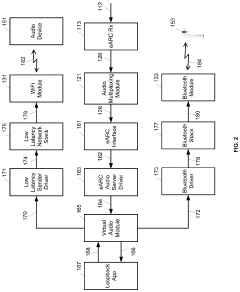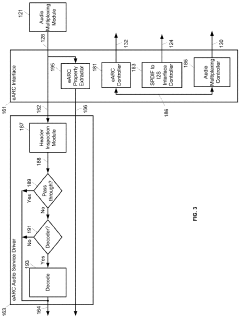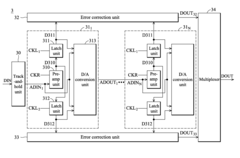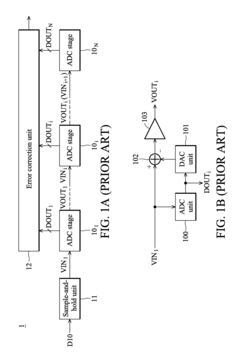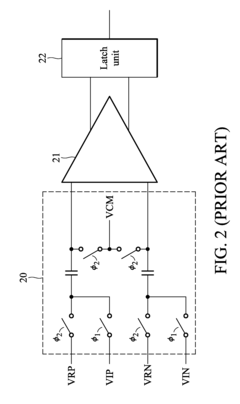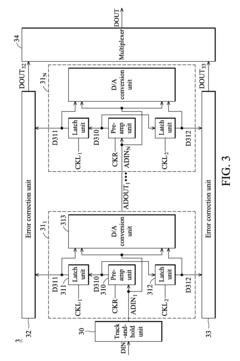How to Equip Sound Technologies with LDAC Support?
JUL 4, 20258 MIN READ
Generate Your Research Report Instantly with AI Agent
Patsnap Eureka helps you evaluate technical feasibility & market potential.
LDAC Technology Overview and Objectives
LDAC, developed by Sony in 2015, represents a significant advancement in wireless audio technology. This high-resolution audio codec aims to deliver near CD-quality sound over Bluetooth connections, addressing the limitations of previous wireless audio transmission methods. LDAC's primary objective is to maximize audio quality while maintaining the convenience of wireless connectivity, a goal that aligns with the growing demand for high-fidelity audio experiences in portable devices.
The technology behind LDAC is built on sophisticated audio compression algorithms that allow for efficient data transmission without significant loss in audio quality. It supports up to 24-bit/96kHz audio at a maximum bitrate of 990 kbps, which is substantially higher than standard Bluetooth codecs like SBC or even aptX. This capability enables LDAC to transmit approximately three times more data than conventional Bluetooth audio codecs, resulting in a richer, more detailed sound reproduction.
LDAC's development was driven by the increasing consumer demand for high-quality audio in wireless devices, particularly as the popularity of streaming services and high-resolution audio formats grew. The technology addresses the bandwidth limitations of Bluetooth by employing adaptive bit rate technology, which allows it to adjust its data transmission rate based on the wireless environment and connection stability.
One of the key objectives of LDAC is to bridge the gap between wired and wireless audio quality. By offering a wireless solution that can rival the performance of wired connections, LDAC aims to cater to audiophiles and music enthusiasts who have traditionally been skeptical of wireless audio solutions. This objective has led to LDAC's adoption by various smartphone manufacturers and audio equipment producers, expanding its reach beyond Sony's own ecosystem.
The evolution of LDAC technology is closely tied to the broader trends in the audio industry, including the shift towards wireless audio solutions and the increasing focus on high-resolution audio formats. As part of the Android Open Source Project since Android 8.0, LDAC has become more accessible to a wider range of devices and manufacturers, furthering its potential for widespread adoption.
Looking forward, the continued development of LDAC technology is expected to focus on further improving audio quality, reducing latency, and enhancing energy efficiency. These advancements will be crucial in maintaining LDAC's competitive edge in the rapidly evolving wireless audio market, where new codecs and technologies are continually emerging to meet the growing demands of consumers for high-quality, wireless audio experiences.
The technology behind LDAC is built on sophisticated audio compression algorithms that allow for efficient data transmission without significant loss in audio quality. It supports up to 24-bit/96kHz audio at a maximum bitrate of 990 kbps, which is substantially higher than standard Bluetooth codecs like SBC or even aptX. This capability enables LDAC to transmit approximately three times more data than conventional Bluetooth audio codecs, resulting in a richer, more detailed sound reproduction.
LDAC's development was driven by the increasing consumer demand for high-quality audio in wireless devices, particularly as the popularity of streaming services and high-resolution audio formats grew. The technology addresses the bandwidth limitations of Bluetooth by employing adaptive bit rate technology, which allows it to adjust its data transmission rate based on the wireless environment and connection stability.
One of the key objectives of LDAC is to bridge the gap between wired and wireless audio quality. By offering a wireless solution that can rival the performance of wired connections, LDAC aims to cater to audiophiles and music enthusiasts who have traditionally been skeptical of wireless audio solutions. This objective has led to LDAC's adoption by various smartphone manufacturers and audio equipment producers, expanding its reach beyond Sony's own ecosystem.
The evolution of LDAC technology is closely tied to the broader trends in the audio industry, including the shift towards wireless audio solutions and the increasing focus on high-resolution audio formats. As part of the Android Open Source Project since Android 8.0, LDAC has become more accessible to a wider range of devices and manufacturers, furthering its potential for widespread adoption.
Looking forward, the continued development of LDAC technology is expected to focus on further improving audio quality, reducing latency, and enhancing energy efficiency. These advancements will be crucial in maintaining LDAC's competitive edge in the rapidly evolving wireless audio market, where new codecs and technologies are continually emerging to meet the growing demands of consumers for high-quality, wireless audio experiences.
Market Demand for High-Quality Audio Codecs
The demand for high-quality audio codecs has been steadily increasing in recent years, driven by the growing consumer appetite for premium audio experiences across various devices and platforms. This trend is particularly evident in the mobile and wireless audio markets, where users increasingly expect studio-quality sound from their smartphones, tablets, and wireless headphones.
LDAC, developed by Sony, has emerged as a leading high-resolution audio codec, capable of transmitting audio at up to 990 kbps, significantly higher than standard Bluetooth codecs. This increased bandwidth allows for the transmission of audio that closely resembles the original recording, meeting the demands of audiophiles and casual listeners alike who seek superior sound quality in their wireless audio devices.
The market for LDAC-enabled devices has seen substantial growth, with major smartphone manufacturers incorporating LDAC support into their flagship models. This adoption has created a ripple effect, encouraging headphone and speaker manufacturers to integrate LDAC compatibility into their products, thus expanding the ecosystem of high-quality audio devices.
Consumer surveys indicate a strong preference for improved audio quality, with many users willing to pay a premium for devices that offer enhanced sound experiences. This willingness to invest in better audio technology has opened up new market opportunities for manufacturers across the audio industry spectrum.
The professional audio sector has also shown increased interest in high-quality codecs like LDAC. Recording studios, live sound engineers, and content creators are looking for ways to maintain audio fidelity throughout the production and distribution chain, creating demand for LDAC-enabled professional audio equipment.
As streaming services continue to offer higher quality audio options, including lossless and high-resolution audio tiers, the need for codecs that can deliver this improved audio quality to end-users becomes more critical. This has led to a growing market for LDAC-compatible streaming devices and services, further driving the demand for the technology.
The automotive industry represents another significant market for high-quality audio codecs. As car manufacturers focus on creating premium in-vehicle entertainment experiences, the integration of advanced audio technologies like LDAC into car audio systems has become a differentiating factor in the luxury vehicle segment.
LDAC, developed by Sony, has emerged as a leading high-resolution audio codec, capable of transmitting audio at up to 990 kbps, significantly higher than standard Bluetooth codecs. This increased bandwidth allows for the transmission of audio that closely resembles the original recording, meeting the demands of audiophiles and casual listeners alike who seek superior sound quality in their wireless audio devices.
The market for LDAC-enabled devices has seen substantial growth, with major smartphone manufacturers incorporating LDAC support into their flagship models. This adoption has created a ripple effect, encouraging headphone and speaker manufacturers to integrate LDAC compatibility into their products, thus expanding the ecosystem of high-quality audio devices.
Consumer surveys indicate a strong preference for improved audio quality, with many users willing to pay a premium for devices that offer enhanced sound experiences. This willingness to invest in better audio technology has opened up new market opportunities for manufacturers across the audio industry spectrum.
The professional audio sector has also shown increased interest in high-quality codecs like LDAC. Recording studios, live sound engineers, and content creators are looking for ways to maintain audio fidelity throughout the production and distribution chain, creating demand for LDAC-enabled professional audio equipment.
As streaming services continue to offer higher quality audio options, including lossless and high-resolution audio tiers, the need for codecs that can deliver this improved audio quality to end-users becomes more critical. This has led to a growing market for LDAC-compatible streaming devices and services, further driving the demand for the technology.
The automotive industry represents another significant market for high-quality audio codecs. As car manufacturers focus on creating premium in-vehicle entertainment experiences, the integration of advanced audio technologies like LDAC into car audio systems has become a differentiating factor in the luxury vehicle segment.
Current LDAC Implementation Challenges
LDAC, developed by Sony, represents a significant advancement in Bluetooth audio codecs. However, its implementation in sound technologies faces several challenges that need to be addressed for wider adoption and improved performance.
One of the primary challenges is the high computational requirements of LDAC. The codec's complex algorithms demand substantial processing power, which can strain the resources of many audio devices, especially those with limited hardware capabilities. This computational intensity can lead to increased power consumption, potentially impacting battery life in portable devices.
Compatibility issues also pose a significant hurdle. LDAC is not universally supported across all operating systems and devices. While it is widely available on Android devices, its integration into other platforms, such as iOS, remains limited. This fragmentation in support creates challenges for manufacturers aiming to provide a consistent high-quality audio experience across different ecosystems.
Licensing and royalty fees associated with LDAC implementation present another obstacle. As a proprietary technology owned by Sony, manufacturers must navigate licensing agreements and associated costs. This can be particularly challenging for smaller companies or those operating on tight margins, potentially limiting the widespread adoption of LDAC in various audio products.
The complexity of LDAC's adaptive bitrate system also presents implementation challenges. The codec can operate at different bitrates (330, 660, and 990 kbps), adjusting based on connection quality and device capabilities. Ensuring smooth transitions between these bitrates and maintaining consistent audio quality across varying conditions requires sophisticated software engineering and thorough testing.
Interoperability with other Bluetooth technologies and codecs is another area of concern. As LDAC coexists with other codecs like aptX and AAC, ensuring seamless switching and optimal performance in multi-codec environments can be technically demanding. This is particularly relevant in scenarios where devices need to support multiple codecs to cater to a wide range of audio sources and receivers.
Furthermore, the implementation of LDAC must address potential latency issues, especially critical in applications like gaming or video playback where audio-visual synchronization is crucial. While LDAC offers high-quality audio, balancing this with low latency performance remains a challenge for many implementations.
Lastly, the integration of LDAC into existing audio processing chains presents its own set of challenges. Manufacturers must carefully consider how LDAC encoding and decoding fit into their signal processing workflows, ensuring that it complements rather than compromises other audio enhancement technologies they may employ.
One of the primary challenges is the high computational requirements of LDAC. The codec's complex algorithms demand substantial processing power, which can strain the resources of many audio devices, especially those with limited hardware capabilities. This computational intensity can lead to increased power consumption, potentially impacting battery life in portable devices.
Compatibility issues also pose a significant hurdle. LDAC is not universally supported across all operating systems and devices. While it is widely available on Android devices, its integration into other platforms, such as iOS, remains limited. This fragmentation in support creates challenges for manufacturers aiming to provide a consistent high-quality audio experience across different ecosystems.
Licensing and royalty fees associated with LDAC implementation present another obstacle. As a proprietary technology owned by Sony, manufacturers must navigate licensing agreements and associated costs. This can be particularly challenging for smaller companies or those operating on tight margins, potentially limiting the widespread adoption of LDAC in various audio products.
The complexity of LDAC's adaptive bitrate system also presents implementation challenges. The codec can operate at different bitrates (330, 660, and 990 kbps), adjusting based on connection quality and device capabilities. Ensuring smooth transitions between these bitrates and maintaining consistent audio quality across varying conditions requires sophisticated software engineering and thorough testing.
Interoperability with other Bluetooth technologies and codecs is another area of concern. As LDAC coexists with other codecs like aptX and AAC, ensuring seamless switching and optimal performance in multi-codec environments can be technically demanding. This is particularly relevant in scenarios where devices need to support multiple codecs to cater to a wide range of audio sources and receivers.
Furthermore, the implementation of LDAC must address potential latency issues, especially critical in applications like gaming or video playback where audio-visual synchronization is crucial. While LDAC offers high-quality audio, balancing this with low latency performance remains a challenge for many implementations.
Lastly, the integration of LDAC into existing audio processing chains presents its own set of challenges. Manufacturers must carefully consider how LDAC encoding and decoding fit into their signal processing workflows, ensuring that it complements rather than compromises other audio enhancement technologies they may employ.
Existing LDAC Integration Solutions
01 LDAC codec implementation in audio devices
LDAC is a high-quality audio codec developed for Bluetooth audio transmission. It allows for higher bitrates and better audio quality compared to standard Bluetooth codecs. Implementation of LDAC in audio devices enables improved wireless audio streaming with near Hi-Res Audio quality.- LDAC codec implementation in audio devices: LDAC is a high-quality audio codec developed for Bluetooth audio transmission. It allows for higher bitrates and better audio quality compared to standard Bluetooth codecs. Implementation of LDAC in audio devices enables improved wireless audio streaming with near Hi-Res Audio quality.
- LDAC integration with mobile devices and applications: LDAC technology is being integrated into various mobile devices and applications to enhance the audio streaming experience. This includes smartphones, tablets, and music streaming apps that support LDAC for high-quality wireless audio transmission to compatible headphones and speakers.
- LDAC compatibility with other audio technologies: Efforts are being made to ensure LDAC compatibility with other audio technologies and standards. This includes integration with various audio processing systems, sound enhancement technologies, and multi-channel audio formats to provide a seamless high-quality audio experience across different devices and platforms.
- LDAC in wireless audio transmission systems: LDAC is being incorporated into wireless audio transmission systems to improve the quality of audio streaming over Bluetooth connections. This includes advancements in signal processing, error correction, and adaptive bitrate technologies to maintain high-quality audio transmission even in challenging wireless environments.
- LDAC support in audio production and professional equipment: LDAC technology is being adopted in professional audio equipment and production tools. This includes integration into studio-grade wireless monitors, recording devices, and mixing consoles to enable high-quality wireless audio monitoring and transmission in professional audio production environments.
02 LDAC integration with mobile devices and applications
LDAC technology is being integrated into various mobile devices and applications to enhance audio streaming capabilities. This includes smartphones, tablets, and music streaming apps that support LDAC for high-quality wireless audio transmission to compatible headphones and speakers.Expand Specific Solutions03 LDAC compatibility in audio receivers and speakers
Audio receivers and speakers are being designed with LDAC support to receive high-quality audio streams from compatible source devices. This enables users to experience improved audio fidelity in their home entertainment systems and portable speakers when paired with LDAC-enabled sources.Expand Specific Solutions04 LDAC in automotive audio systems
Automotive manufacturers are incorporating LDAC technology into their in-car entertainment systems. This allows for high-quality audio streaming from passengers' mobile devices to the car's audio system, enhancing the in-vehicle audio experience.Expand Specific Solutions05 LDAC optimization and power efficiency
Ongoing research and development efforts are focused on optimizing LDAC technology for better power efficiency and performance. This includes improvements in encoding and decoding algorithms, as well as hardware optimizations to reduce power consumption while maintaining high audio quality.Expand Specific Solutions
Key Players in LDAC Ecosystem
The market for LDAC support in sound technologies is in a growth phase, with increasing demand for high-quality wireless audio solutions. The market size is expanding as more consumers seek premium audio experiences. Technologically, LDAC is maturing, with key players like Sony Group Corp., the creator of LDAC, leading the way. Companies such as MediaTek, Qualcomm, and Cirrus Logic are also contributing to the ecosystem by integrating LDAC support into their audio chipsets. The competitive landscape is evolving, with traditional audio companies like Yamaha and emerging players like Skyworks Solutions vying for market share. As LDAC becomes more widely adopted, we can expect increased competition and innovation in this space.
MediaTek, Inc.
Technical Solution: MediaTek has taken a software-centric approach to equipping their chipsets with LDAC support. Their solution involves integrating LDAC decoding capabilities into their audio processing software stack, which runs on the digital signal processor (DSP) within their SoCs [7]. This approach allows for flexibility in implementation across various chipset models. MediaTek has also focused on optimizing the LDAC decoding process to minimize power consumption, a crucial factor for mobile devices [8]. Additionally, they have worked on improving the Bluetooth connectivity stack to ensure stable transmission of high-bitrate LDAC streams, addressing potential issues with wireless interference [9].
Strengths: Flexible implementation across various chipsets, focus on power efficiency, improved Bluetooth stability. Weaknesses: Potentially higher CPU usage compared to hardware-based solutions, reliance on software updates for improvements.
QUALCOMM, Inc.
Technical Solution: Qualcomm has developed a comprehensive approach to integrating LDAC support into their Snapdragon mobile platforms. Their solution involves incorporating LDAC decoding capabilities directly into their audio codec hardware, such as the Qualcomm WCD9385 audio codec [4]. This integration allows for efficient processing of LDAC streams without significant additional CPU load. Qualcomm has also optimized their Bluetooth audio stack to support LDAC transmission, enabling seamless connectivity between LDAC-enabled devices [5]. Furthermore, they have implemented power optimization techniques to minimize battery drain when using LDAC, addressing one of the key concerns with high-bitrate audio codecs [6].
Strengths: Wide adoption in Android devices, hardware-level integration for efficiency, optimized power consumption. Weaknesses: Dependent on Sony's licensing terms, limited control over codec development.
Core LDAC Patents and Technical Specifications
Audio Return Channel Data Loopback
PatentActiveUS20210098011A1
Innovation
- A media device substitutes an externally generated clock derived from a local crystal oscillator for the missing sampling clock, synchronizing it with the input sampling clock frequency, and switches back when the input clock reappears, while inserting zero padding to mitigate sound glitches, and optionally buffers audio data during clock transitions to maintain sound continuity.
Analog-to-digital conversion devices and analog-to-digital conversion stages thereof
PatentActiveUS7768432B2
Innovation
- A time-interleaved analog-to-digital conversion device with a shared pre-amp unit among two latch units, where the pre-amp is reset between the enablement times of the latch units, reducing the overall area and power consumption.
LDAC Licensing and Compliance Requirements
LDAC licensing and compliance requirements are crucial aspects for manufacturers and developers seeking to integrate this advanced audio codec into their sound technologies. Sony, the creator of LDAC, has established a comprehensive licensing program to ensure the proper implementation and quality control of LDAC-enabled devices.
To obtain LDAC support, companies must first enter into a licensing agreement with Sony. This process typically involves negotiating terms, paying licensing fees, and agreeing to comply with Sony's technical specifications and quality standards. The licensing agreement grants the licensee the right to use LDAC technology in their products and access to the necessary technical documentation and support.
Once licensed, manufacturers must adhere to strict compliance requirements to maintain LDAC certification. These requirements encompass various aspects of product development and quality assurance. Firstly, licensees must implement LDAC according to Sony's technical specifications, ensuring that the codec's performance meets the established benchmarks for audio quality and transmission efficiency.
Quality control is a critical component of LDAC compliance. Manufacturers are required to conduct rigorous testing of their LDAC-enabled devices to verify proper functionality and performance. This includes testing for audio quality, latency, connection stability, and compatibility with other LDAC-certified devices. Sony may also require licensees to submit their products for independent testing and certification to ensure compliance with LDAC standards.
Compliance requirements extend to the user interface and product documentation as well. Licensees must clearly indicate LDAC support in their product specifications and user manuals, providing consumers with accurate information about the device's audio capabilities. Additionally, the LDAC logo must be displayed according to Sony's branding guidelines to maintain consistency across all LDAC-enabled products.
Ongoing compliance is essential for maintaining LDAC certification. Sony may conduct periodic audits or require regular reporting from licensees to ensure continued adherence to LDAC standards. This may include submitting updated product information, test results, or participating in compliance reviews.
For companies developing software applications that interact with LDAC-enabled devices, there may be additional compliance requirements. These could include implementing specific APIs or protocols to ensure proper communication with LDAC hardware and maintaining compatibility with Sony's software development kits (SDKs).
To obtain LDAC support, companies must first enter into a licensing agreement with Sony. This process typically involves negotiating terms, paying licensing fees, and agreeing to comply with Sony's technical specifications and quality standards. The licensing agreement grants the licensee the right to use LDAC technology in their products and access to the necessary technical documentation and support.
Once licensed, manufacturers must adhere to strict compliance requirements to maintain LDAC certification. These requirements encompass various aspects of product development and quality assurance. Firstly, licensees must implement LDAC according to Sony's technical specifications, ensuring that the codec's performance meets the established benchmarks for audio quality and transmission efficiency.
Quality control is a critical component of LDAC compliance. Manufacturers are required to conduct rigorous testing of their LDAC-enabled devices to verify proper functionality and performance. This includes testing for audio quality, latency, connection stability, and compatibility with other LDAC-certified devices. Sony may also require licensees to submit their products for independent testing and certification to ensure compliance with LDAC standards.
Compliance requirements extend to the user interface and product documentation as well. Licensees must clearly indicate LDAC support in their product specifications and user manuals, providing consumers with accurate information about the device's audio capabilities. Additionally, the LDAC logo must be displayed according to Sony's branding guidelines to maintain consistency across all LDAC-enabled products.
Ongoing compliance is essential for maintaining LDAC certification. Sony may conduct periodic audits or require regular reporting from licensees to ensure continued adherence to LDAC standards. This may include submitting updated product information, test results, or participating in compliance reviews.
For companies developing software applications that interact with LDAC-enabled devices, there may be additional compliance requirements. These could include implementing specific APIs or protocols to ensure proper communication with LDAC hardware and maintaining compatibility with Sony's software development kits (SDKs).
LDAC Performance Benchmarking
LDAC performance benchmarking is crucial for evaluating the effectiveness of LDAC support in sound technologies. This process involves comprehensive testing and analysis to assess the codec's capabilities across various parameters.
One key aspect of LDAC performance benchmarking is measuring the audio quality at different bitrates. LDAC supports multiple transmission rates, including 330 kbps, 660 kbps, and 990 kbps. Comparative analysis of these bitrates against other codecs, such as SBC, aptX, and AAC, provides insights into LDAC's superior audio fidelity, especially at higher bitrates.
Latency testing is another critical component of LDAC performance evaluation. By measuring the delay between audio transmission and playback, benchmarking can determine LDAC's suitability for various applications, particularly those requiring real-time audio processing. This assessment typically involves comparing LDAC's latency with other Bluetooth codecs to highlight its advantages in reducing audio lag.
Power consumption is a significant factor in wireless audio technologies. LDAC performance benchmarking includes analyzing the codec's energy efficiency across different devices and usage scenarios. This evaluation helps determine the impact of LDAC support on battery life for both transmitting and receiving devices, which is crucial for portable audio equipment.
Compatibility testing forms an essential part of LDAC benchmarking. This involves assessing LDAC's performance across a wide range of devices, including smartphones, tablets, headphones, and speakers. The benchmarking process examines how well LDAC integrates with various hardware configurations and operating systems, ensuring broad compatibility and consistent performance across different platforms.
Stability and connection reliability are also key benchmarking criteria. Tests are conducted to evaluate LDAC's performance under various environmental conditions, such as in areas with high electromagnetic interference or at different distances between the transmitting and receiving devices. This helps in understanding the codec's robustness and its ability to maintain high-quality audio transmission in challenging scenarios.
Finally, LDAC performance benchmarking includes assessing the codec's scalability and adaptability. This involves testing how well LDAC adjusts its performance based on network conditions and device capabilities, ensuring optimal audio quality and stability across varying usage environments. The ability to dynamically switch between different bitrates without noticeable audio degradation is a key feature that distinguishes LDAC from other codecs.
One key aspect of LDAC performance benchmarking is measuring the audio quality at different bitrates. LDAC supports multiple transmission rates, including 330 kbps, 660 kbps, and 990 kbps. Comparative analysis of these bitrates against other codecs, such as SBC, aptX, and AAC, provides insights into LDAC's superior audio fidelity, especially at higher bitrates.
Latency testing is another critical component of LDAC performance evaluation. By measuring the delay between audio transmission and playback, benchmarking can determine LDAC's suitability for various applications, particularly those requiring real-time audio processing. This assessment typically involves comparing LDAC's latency with other Bluetooth codecs to highlight its advantages in reducing audio lag.
Power consumption is a significant factor in wireless audio technologies. LDAC performance benchmarking includes analyzing the codec's energy efficiency across different devices and usage scenarios. This evaluation helps determine the impact of LDAC support on battery life for both transmitting and receiving devices, which is crucial for portable audio equipment.
Compatibility testing forms an essential part of LDAC benchmarking. This involves assessing LDAC's performance across a wide range of devices, including smartphones, tablets, headphones, and speakers. The benchmarking process examines how well LDAC integrates with various hardware configurations and operating systems, ensuring broad compatibility and consistent performance across different platforms.
Stability and connection reliability are also key benchmarking criteria. Tests are conducted to evaluate LDAC's performance under various environmental conditions, such as in areas with high electromagnetic interference or at different distances between the transmitting and receiving devices. This helps in understanding the codec's robustness and its ability to maintain high-quality audio transmission in challenging scenarios.
Finally, LDAC performance benchmarking includes assessing the codec's scalability and adaptability. This involves testing how well LDAC adjusts its performance based on network conditions and device capabilities, ensuring optimal audio quality and stability across varying usage environments. The ability to dynamically switch between different bitrates without noticeable audio degradation is a key feature that distinguishes LDAC from other codecs.
Unlock deeper insights with Patsnap Eureka Quick Research — get a full tech report to explore trends and direct your research. Try now!
Generate Your Research Report Instantly with AI Agent
Supercharge your innovation with Patsnap Eureka AI Agent Platform!
